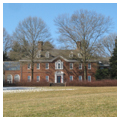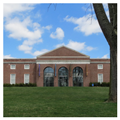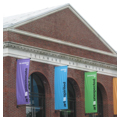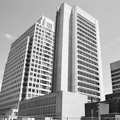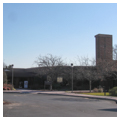As with states farther south, architectural modernism took only shallow root in Delaware and was usually diluted with historicizing motifs. But as early as the 1930s, a few architects embraced it enthusiastically. Victorine du Pont met her husband and partner Samuel Homsey in an architect's office in Boston. After their practice was wiped out in the Great Depression, they settled in Wilmington and undertook a career that was both historicizing (Mount Cuba, 1935–1937 [MC4], which emulated Colonial Williamsburg) and progressive (their starkly modernist, and now demolished, Henry B. Robertson House in Centreville of 1936 was depicted in Architectural Forum in February 1938 and honored by the Museum of Modern Art). For the Delaware Art Museum (WL90), Sam proposed four facade designs ranging from Georgian Revival to Moderne.
About the same time, the arrival of William Moeckel to work for Brown and Whiteside began the transformation of that firm's work from Colonial Revival to International Style. One observes, in microcosm, how the cutting-edge styles of the 1930s, having crossed the Atlantic, now invaded a provincial outpost. The process continued postwar, as even diehard historicists went modern; for example, E. William Martin, renowned for Colonial Revival schools in the 1930s, embraced the International Style by the time of his Newark Elementary School (now much altered as Graham Hall, University of Delaware) in 1948–1949.
Never numerous in Delaware, pure modernist examples are rapidly vanishing. Recently lost to partial demolition and remodeling of the remainder is Newark's Chrysler Plant and, in the same city, the Avon Plant (NK7); three automobile dealerships in Wilmington; and the Henry B. Robertson House. Edge Moor Elementary 1947–1948, Robinson, Stanhope and Manning, on the cutting edge of International Style modernism nationwide, with low, radiating wings that allowed every classroom to be bathed in sunlight, was, by 2003, a vandalized wreck awaiting demolition (its twin a few miles away survives in mutilated form, BR14). Edgemoor Theatre (1941, Armand Carroll), Wilmington's best example of Streamline Moderne, was destroyed in 1987. In 1999, a geographer identified Art Deco examples in surprisingly many Wilmington towns but noted their disappearance even as he studied them. Delaware's only building by I. M. Pei, a Wilmington skyscraper (WL37), was “improved” in 2003, prettifying a Brutalist masterpiece of the 1960s—somehow predictable in a state that has shown little sympathy for bold modernist experiments.
Writing Credits
If SAH Archipedia has been useful to you, please consider supporting it.
SAH Archipedia tells the story of the United States through its buildings, landscapes, and cities. This freely available resource empowers the public with authoritative knowledge that deepens their understanding and appreciation of the built environment. But the Society of Architectural Historians, which created SAH Archipedia with University of Virginia Press, needs your support to maintain the high-caliber research, writing, photography, cartography, editing, design, and programming that make SAH Archipedia a trusted online resource available to all who value the history of place, heritage tourism, and learning.


